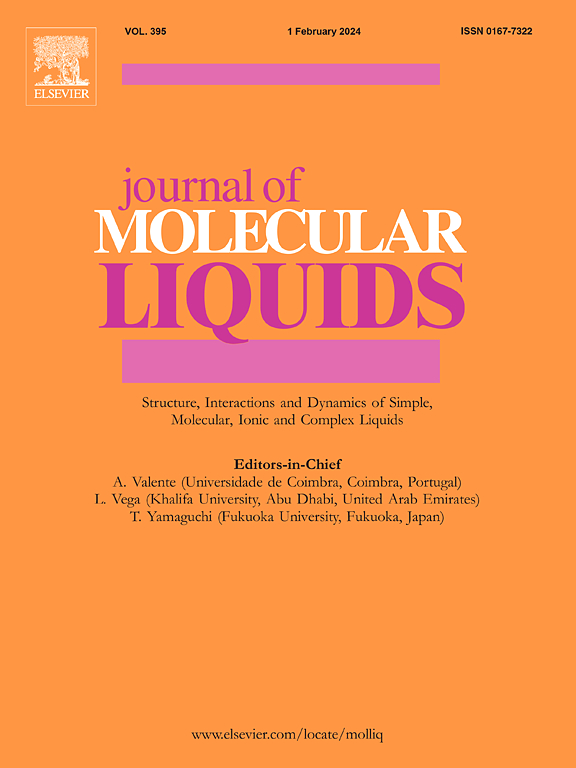[BMIM][F]离子液体中芳基和杂芳基磺酰氟的微波辅助、便捷和绿色合成:分子对接和生物学研究
IF 5.3
2区 化学
Q2 CHEMISTRY, PHYSICAL
引用次数: 0
摘要
在绿色化学原理的鼓励下,利用[BMIM][F]离子液体介质中KF的催化量,在100°C下,研究了微波辅助合成多种芳基/杂芳基磺酰氟化合物的方法。用1H NMR、13C NMR、19F NMR、GC-MS等光谱方法对合成的化合物进行了表征,并报道了化合物的x射线数据。用于合成这些分子的绿色溶剂的效率取决于其回收和再利用最多5个循环。通过密度功能测试,利用分子静电势的三维图来识别亲核和亲电位点。此外,还估计了全球化学反应描述符参数,如化学硬度、柔软度、化学势、电负性和亲电性指数。对新合成的化合物进行抑菌研究,发现化合物13和12比具有杀菌和杀真菌特性的对照治疗剂具有更高的抑菌活性。以抗坏血酸为对照,采用DPPH自由基清除法测定化合物的抗氧化活性。化合物12的活性最高,而化合物09、11和13的活性较弱。构效关系表明,化合物12的铬磺酰胺片段对自由基的稳定起重要作用。与细菌甲羟戊酸二磷酸脱羧酶和真菌甾醇14- α去甲基化酶的分子对接模拟表明,化合物12和13对前者的结合亲和力最高,而化合物13对后者的结合能力优于氟康唑。这些相互作用表明有很强的酶抑制潜力。综上所述,化合物13是一种很有前景的双靶点抗菌候选药物。分子相互作用谱突出了两种靶标与关键活性位点残基的关键相互作用,强调了它们作为广谱抗菌抑制剂的潜力。本文章由计算机程序翻译,如有差异,请以英文原文为准。
![Microwave-assisted, facile and green synthesis of aryl and heteroaryl sulfonyl fluorides in [BMIM][F] ionic liquid: Molecular docking and biological studies](https://img.booksci.cn/booksciimg/2025-7/102305641181783836175.jpg)
Microwave-assisted, facile and green synthesis of aryl and heteroaryl sulfonyl fluorides in [BMIM][F] ionic liquid: Molecular docking and biological studies
Encouraged by one of principles of green chemistry, A microwave assisted synthesis of variety of aryl/heteroaryl sulfonyl fluorides were demonstrated by utilizing catalytic amount of KF in [BMIM][F] ionic liquid medium at 100 °C. All the synthesized compounds were characterized by spectroscopic methods such as 1H NMR, 13C NMR, 19F NMR, GC–MS and X-Ray data of compounds was also reported. The efficiency of the green solvent employed for synthesizing these molecules is determined by its recycle and reuse for a maximum of 5 cycles. From the Density Functional Test, 3D plots of molecular Electrostatic Potential were used to identify nucleophilic and electrophilic sites. Additionally, Global Chemical Reactivity Descriptor parameters like chemical hardness, softness, chemical potential, electronegativity, and electrophilicity index were also estimated. The antibacterial study of the newly synthesized compounds revealed that compounds 13 and 12 were found to exhibit higher antimicrobial activities as compare to reference therapeutics having both bactericidal and fungicidal properties. The antioxidant activity of compounds was done by using the DPPH radical scavenging assay with ascorbic acid as a control. Amoung the tested compounds, Compound 12 was most active, while compounds 09, 11, and 13 had comparatively weaker activities. Structure–activity relationship indicates that chromenesulfonamide fragment of compound 12 was responsible in improved radical stabilization. Molecular docking simulations with bacterial mevalonate diphosphate decarboxylase and fungal sterol 14-alpha demethylase showed that Compounds 12 and 13 exhibited the highest binding affinities towards the former, while compound 13 demonstrated superior binding to the latter, exceeding fluconazole. These interactions suggest strong enzyme inhibition potential. Overall, compound 13 emerges as a promising dual-target antimicrobial candidate. The molecular interaction profile highlighted key interactions with critical active site residues in both the targets, emphasizing their promising potential as broad-spectrum antimicrobial inhibitors.
求助全文
通过发布文献求助,成功后即可免费获取论文全文。
去求助
来源期刊

Journal of Molecular Liquids
化学-物理:原子、分子和化学物理
CiteScore
10.30
自引率
16.70%
发文量
2597
审稿时长
78 days
期刊介绍:
The journal includes papers in the following areas:
– Simple organic liquids and mixtures
– Ionic liquids
– Surfactant solutions (including micelles and vesicles) and liquid interfaces
– Colloidal solutions and nanoparticles
– Thermotropic and lyotropic liquid crystals
– Ferrofluids
– Water, aqueous solutions and other hydrogen-bonded liquids
– Lubricants, polymer solutions and melts
– Molten metals and salts
– Phase transitions and critical phenomena in liquids and confined fluids
– Self assembly in complex liquids.– Biomolecules in solution
The emphasis is on the molecular (or microscopic) understanding of particular liquids or liquid systems, especially concerning structure, dynamics and intermolecular forces. The experimental techniques used may include:
– Conventional spectroscopy (mid-IR and far-IR, Raman, NMR, etc.)
– Non-linear optics and time resolved spectroscopy (psec, fsec, asec, ISRS, etc.)
– Light scattering (Rayleigh, Brillouin, PCS, etc.)
– Dielectric relaxation
– X-ray and neutron scattering and diffraction.
Experimental studies, computer simulations (MD or MC) and analytical theory will be considered for publication; papers just reporting experimental results that do not contribute to the understanding of the fundamentals of molecular and ionic liquids will not be accepted. Only papers of a non-routine nature and advancing the field will be considered for publication.
 求助内容:
求助内容: 应助结果提醒方式:
应助结果提醒方式:


